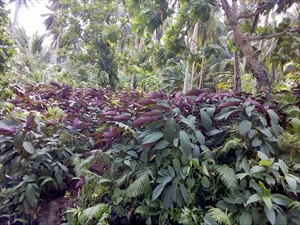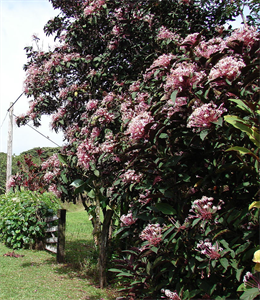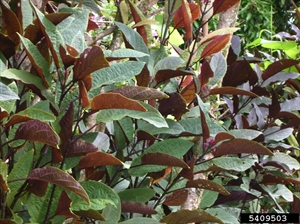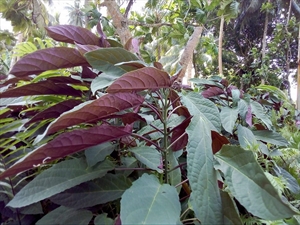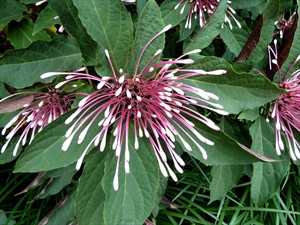Fireworks; it is also known as firecracker, Philippine glory-bower, or starburst bush. CABI prefers the name bronze-leaved clerodendrum.
Pacific Pests, Pathogens and Weeds - Online edition
Pacific Pests, Pathogens & Weeds
Fireworks (445)
Clerodendrum quadriloculare. It is a member of the Lamiaceae.
Asia, North America (restricted), the Caribbean (restricted), Oceania. It is recorded from American Samoa, Federated States of Micronesia, Fiji, French Polynesia, Guam, Marshall Islands, Northern Mariana Islands, Palau, Papua New Guinea, and Samoa.
It is native to Papua New Guinea and the Philippines.
An important invasive weed. It is an attractive ornamental cultivated in backyards and gardens. However, it is very aggressive, growing rapidly, producing large amounts of viable seed, and root suckers prolifically, forming dense thickets along roadsides, waste grounds, abandoned plantations, and disturbed areas (Photos 1&2). Tolerant of shade.
A perennial shrub up to 5 m high (Photo 2). The stems are almost quadrangular (four-sided) in section. Leaves are in pairs, oblong, 15-20 cm long, with pointed tips, rounded base and wavy margins (Photo 3). The upper surface is green, and the lower surface dark-purple (Photo 4). There are many flowers in showy large flat-topped clusters, each a narrow pink tube, 5-8 cm long, ending in five-curved white petals about 1.5 cm long (Photos 5-7). Fruits are ellipsoid (earth-shaped), 1-1.5 cm long, containing four seeds.
Spread over short distances is by root suckers. Over both short and long distances, spread is by seeds eaten by birds and other animals. Seeds, pieces of root and cuttings are also dispersed in soil, sand, and gravel.
After introduction as an ornamental to southwest Pacific countries, fireworks has rapidly becoming an invasive weed; the same has happened in Guam in the north Pacific and in Puerto Rico in the Caribbean. In all these places, it has been planted in gardens and then escaped into cultivated and natural areas with the result that native vegetation has been displaced. Its potential to invade relatively intact native forest makes this weed potentially very important. For instance, in Pohnpei, Federated States of Micronesia, is occurs in full shade under forest canopy as a dense understory.
It is used as a hedge, a specimen plant in gardens, and in median strips along roads. it is also used in traditional Philippine medicine to treat wounds and ulcers.
BIOSECURITY
There is a high risk of introduction of fireworks because of its showy flowers make it appealing as an ornamental. Countries not yet infested should consider all likely pathways for entry, and apply quarantine measures accordingly. Special consideration should be given to the part played by the domestic and international trade in ornamental plants, as well as traditional medicines, in the spread of this invasive weed.
BIOLOGICAL CONTROL
No information available.
CULTURAL CONTROL
-
Physical & Mechanical
-
Hand weed or dig out the plants, but reports that if left too long plants are difficult to remove manually.
-
CHEMCIAL CONTROL
There are no herbicides registered for this weed in Australia. In Fiji, glyphosate. The following are also suggested from the chemical control of Clerodendrum chinense (Honolulu rose) (see Fact Sheet no. 443):
-
Foliar applications: picloram; triclopyr; 2,4-D; metsulfuron-methyl. There are products which combine picloram + triclopyr; picloram + 2,4-D; dicamba + 2,4-D.
-
Cut-stump applications of the same herbicides. (See Fact Sheet no. 442 for methods).
-
Soil applications: fluroxypyr.
For foliar applications, it is recommended that the plants are slashed, and the new growth is then sprayed.
--------------------
In the EU, approval to use glyphosate ends in December 2022; its use after that date is under discussion.
____________________
When using a pesticide, always wear protective clothing and follow the instructions on the product label, such as dosage, timing of application, and pre-harvest interval. Recommendations will vary with the crop and system of cultivation. Expert advice on the most appropriate herbicides to use should always be sought from local agricultural authorities.
AUTHORS Grahame Jackson, Aradhana Deesh & Mani Mua
Information from CABI (2019) Clerodendrum quadriloculare (bronzed-leaved clerodendrum). Invasive Species Compendium. (https://www.cabi.org/isc/datasheet/14334); and from Pacific Island Ecosystems at Risk (2013) Clerodendrum quadriloculare. (http://www.hear.org/pier/species/clerodendrum_quadriloculare.htm). Photos 1-4 Forest and Kim Star, Star Environmental, Bugwood.org.
Produced with support from the Australian Centre for International Agricultural Research under project HORT/2016/185: Responding to emerging pest and disease threats to horticulture in the Pacific islands, implemented by the University of Queensland, in association with the Pacific Community and Koronivia Research Station, Ministry of Agriculture, Fiji.
